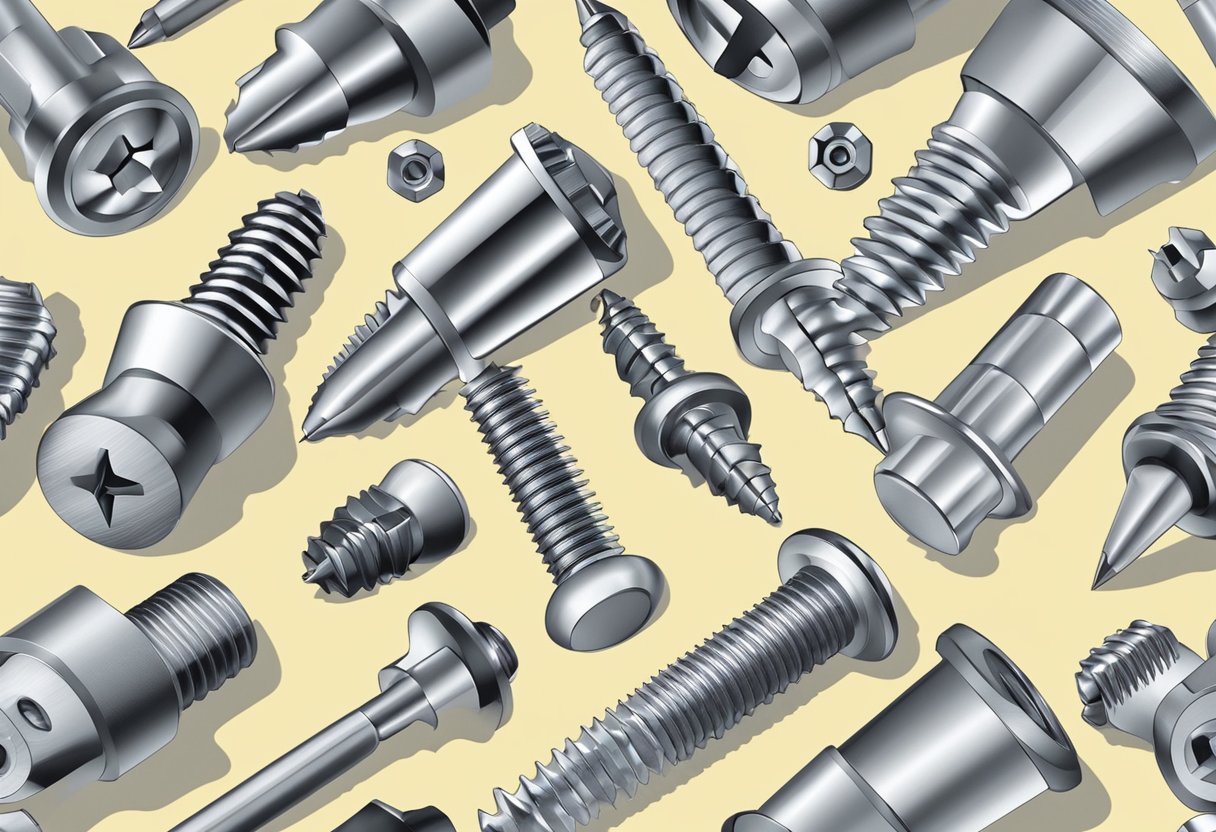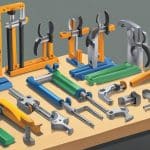Types Of Screw Heads
When it comes to fastening materials together, screws are one of the most versatile and commonly used types of fasteners. One of the most important aspects of any screw is its head, which determines how it can be driven and what applications it is best suited for. There are many different types of screw heads available, each with its own unique features and benefits.

Basic Screw Head Shapes
The most common screw head shapes include flat, oval, round, pan, and truss. Flat and oval heads are typically countersunk and used for applications where the screw head needs to be flush with the surface of the material. Round heads are also sometimes countersunk, but are more commonly used in applications where the screw head needs to protrude slightly. Pan and truss heads are both slightly rounded and are used in applications where a more decorative or finished look is desired.
Drive Types
Another important aspect of screw heads is the type of drive they use. Common drive types include slotted, Phillips, Torx, and hex. Slotted drives are the oldest and simplest type of drive, but are also the least secure. Phillips drives are more secure and easier to use, while Torx and hex drives offer even greater security and are commonly used in high-torque applications.
Key Takeaways:
- Understanding the different types of screw heads is important for selecting the right fastener for any given application.
- Basic screw head shapes include flat, oval, round, pan, and truss.
- Common drive types include slotted, Phillips, Torx, and hex.
Basic Screw Head Shapes
Screw heads come in various shapes and sizes, each designed for specific purposes. Here are some of the most common basic screw head shapes:
Flat Head
Flat head screws have a countersunk head with a flat top surface and a conical bearing surface. They are commonly used in woodworking and are ideal for applications where the screw head needs to be flush with the surface of the material. Flat head screws are also known as countersunk screws.
Round Head
Round head screws have a dome-shaped head with a flat bearing surface. They are used in applications where a decorative finish is desired or where a higher profile is acceptable. Round head screws are also known as mushroom head screws.
Pan Head
Pan head screws have a slightly rounded head with a flat bearing surface. They are used in applications where a low profile is required and are commonly used in electronics and automotive applications. Pan head screws are also known as rounded head screws.
Oval Head
Oval head screws have a slightly domed head with a flat bearing surface. They are used when a more aesthetic finish is desired without sacrificing the screw’s strength. Oval head screws are commonly used in furniture and cabinetry.
Truss Head
Truss head screws have a low profile, wide head with a flat bearing surface. They are used in applications where a low profile is required and where a high level of torque is needed. Truss head screws are commonly used in automotive and aerospace applications.
In conclusion, understanding the basic screw head shapes is essential in selecting the right screw for a specific application. Each screw head shape has its own unique properties and advantages. By choosing the right screw head shape, one can ensure a secure and aesthetically pleasing finish.
Drive Types
When it comes to screw heads, the drive type refers to the shape of the recess in the head of the screw that allows for a tool to be inserted and turned. The most common drive types include slotted, Phillips, hex, Torx, and Robertson.
Slotted Drive
Slotted drive screws, also known as flathead screws, have a single horizontal slot in the head that is designed to be used with a flat-bladed screwdriver. They are commonly used in woodworking and other applications where a flush finish is desired.
Phillips Drive
Phillips drive screws have a cross-shaped recess in the head that is designed to be used with a Phillips screwdriver. They are commonly used in construction and automotive applications, and are known for their ability to provide high torque with minimal slippage.
Hex Drive
Hex drive screws have a hexagonal recess in the head that is designed to be used with a hex key or Allen wrench. They are commonly used in machinery and automotive applications, and are known for their ability to provide high torque with minimal slippage.
Torx Drive
Torx drive screws have a star-shaped recess in the head that is designed to be used with a Torx screwdriver. They are commonly used in electronics and automotive applications, and are known for their ability to provide high torque with minimal slippage.
Robertson Drive
Robertson drive screws, also known as square drive screws, have a square-shaped recess in the head that is designed to be used with a Robertson screwdriver. They are commonly used in woodworking and construction applications, and are known for their ability to provide high torque with minimal slippage.
Overall, the choice of screw drive type will depend on the specific application and the amount of torque required. It is important to select the appropriate screw drive type to ensure proper installation and avoid damage to the screw or surrounding materials.
Specialized Screw Heads
When it comes to specialized screw heads, there are a few types that stand out. These screw heads are designed to provide additional security and tamper-resistance, making them ideal for high-security applications.
Security Heads
Security heads are designed to prevent unauthorized removal of the screw. These heads come in a variety of shapes, including the Torx Plus, Spanner, and Tri-Wing. The Torx Plus head is a six-pointed star shape that provides a high level of torque transfer. The Spanner head has two round notches that require a special tool to remove. The Tri-Wing head has three wings that provide a secure grip for the screwdriver.
Tamper-Resistant Heads
Tamper-resistant heads are designed to prevent tampering or vandalism. These heads come in a variety of shapes, including the Torx Plus, Spanner, and Tri-Wing. The Torx Plus head is a six-pointed star shape that provides a high level of torque transfer. The Spanner head has two round notches that require a special tool to remove. The Tri-Wing head has three wings that provide a secure grip for the screwdriver.
Overall, specialized screw heads are an important part of many high-security applications. By using these heads, you can ensure that your screws are secure and tamper-resistant. Whether you need a Torx Plus, Spanner, or Tri-Wing head, there is a screw head out there that will meet your needs.
Screw Head Applications
Screw heads come in different shapes and sizes, and each type has its own specific application. Knowing the right screw head to use for a particular job is essential to ensure a secure and long-lasting installation. Here are some common screw head applications:
Wood Screws
Wood screws are threaded screws that are designed to be used with wood. They have a tapered shank and a sharp point that allows them to penetrate the wood easily. Wood screws come in different lengths and gauges, and their heads can be flat, oval, or round. Flathead wood screws are ideal for countersinking, while roundhead wood screws are perfect for applications where the screw head needs to be visible.
Machine Screws
Machine screws are threaded screws that are designed to be used with metal. They have a uniform diameter and a flat or rounded head. Machine screws come in different lengths and gauges, and their heads can be slotted, Phillips, or hexagonal. Slotted machine screws are ideal for applications where a flathead screwdriver is required, while Phillips machine screws are perfect for applications where a Phillips screwdriver is needed.
Drywall Screws
Drywall screws are threaded screws that are designed to be used with drywall. They have a sharp point and a bugle head that allows them to penetrate the drywall easily. Drywall screws come in different lengths and gauges, and their heads can be Phillips or square. Phillips drywall screws are ideal for applications where a Phillips screwdriver is required, while square drywall screws are perfect for applications where a square driver is needed.
In conclusion, choosing the right screw head for a particular job is essential to ensure a secure and long-lasting installation. Wood screws are ideal for wood applications, machine screws are perfect for metal applications, and drywall screws are designed for drywall applications.
Selecting the Right Screw Head
When it comes to selecting the right screw head, there are several factors to consider. The choice of screw head depends on the type of material you are working with, the level of torque required, and the tool you will be using to install the screw.
One of the most common screw heads is the Phillips head. This type of screw head is designed to be used with a Phillips screwdriver, which has a cross-shaped tip. Phillips screws are widely used in the construction industry, as they are easy to install and offer good torque control.
Another popular screw head is the hex head. This type of screw head has six sides and is often used in automotive and machinery applications. Hex screws can be tightened with a wrench or socket, making them ideal for high-torque applications.
For more specialized applications, there are other screw head types available, such as the Torx and Pozidriv screw heads. Torx screws have a star-shaped head and are commonly used in electronics and automotive applications. Pozidriv screws are similar to Phillips screws but have additional contact points, providing better torque control.
In addition to the type of screw head, it is also important to consider the size and length of the screw. The size of the screw is typically indicated by a number, with larger numbers indicating larger screws. The length of the screw is measured from the top of the head to the tip of the screw.
When selecting screws, it is important to choose the right fastener for the job. Fasteners such as nuts and bolts are used to secure two or more objects together. The choice of fastener depends on the type of material being joined and the level of strength required.
In summary, selecting the right screw head is important for ensuring a secure and long-lasting connection. Consider the type of material being worked with, the level of torque required, and the tool being used to install the screw. Choose the right size and length of screw, and select the appropriate fastener for the job.






